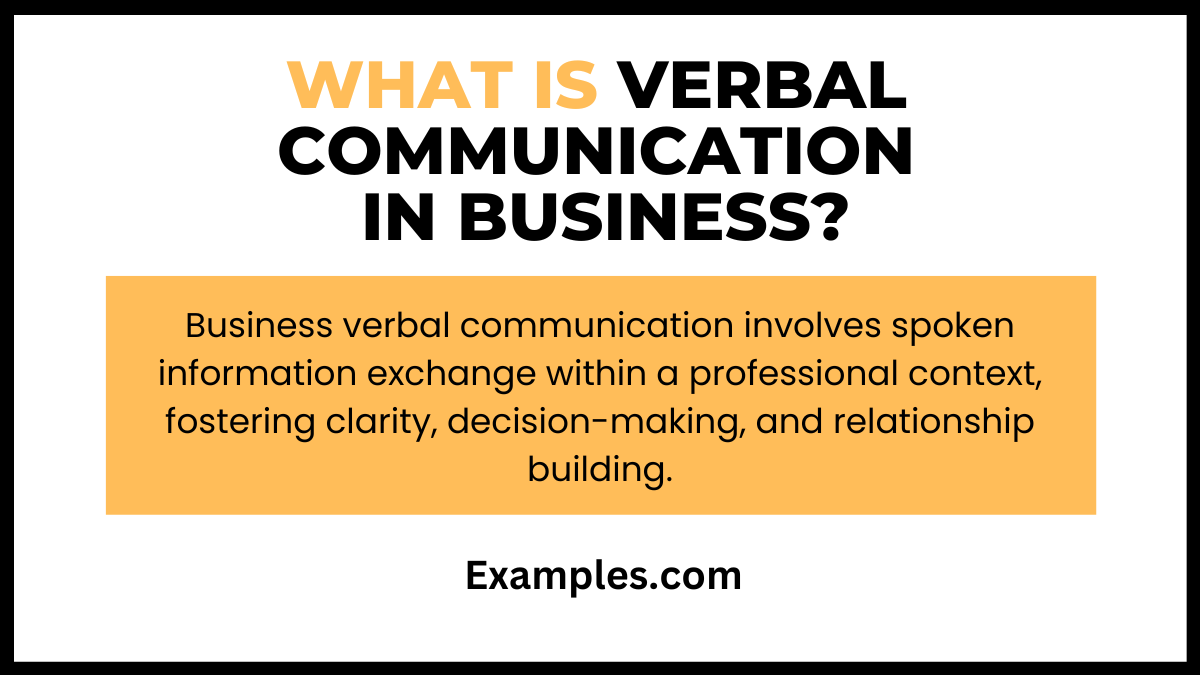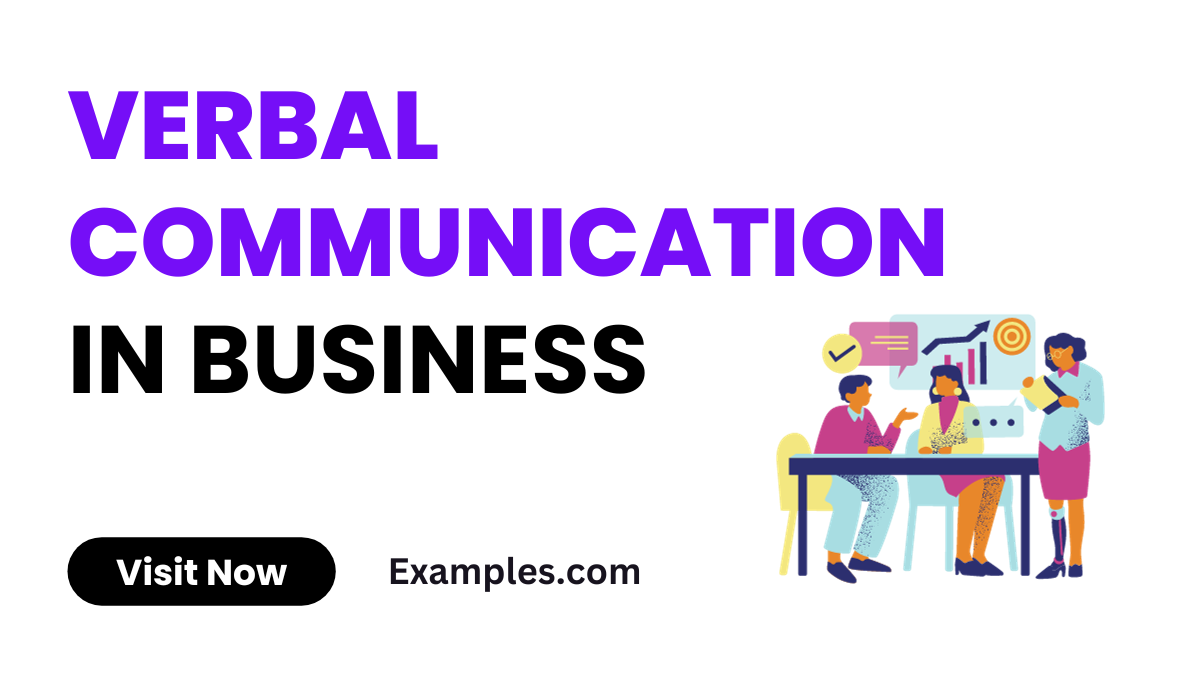19+ Verbal Communication in Business Examples
Dive into the world of business with our comprehensive guide on verbal communication, the backbone of corporate success. Understand the nuances through practical Communication Examples, enhancing your professional verbal exchange. This guide ensures you grasp the essence of effective dialogue, tailored with strategies and real-life business speaking skills. Learn to navigate the corporate landscape with confidence, armed with the best verbal tools.
Download Importance of Verbal Communication in Business PDF
What is Verbal Communication in Business? – Meaning

Verbal communication in business refers to the spoken exchange of information, ideas, and emotions between individuals or groups within a professional setting. It is a fundamental aspect of business operations, aiding in decision-making, relationship building, and problem-solving. Whether through face-to-face conversations, phone calls, or virtual meetings, effective verbal communication is vital for clarity, efficiency, and overall business success.
What is the Best Example of Verbal Communication in Business?

One of the best examples of verbal communication in business is the structured, strategic meeting. These meetings involve clear agendas, active participation, and open dialogue to align goals, solve problems, and make decisions. They showcase effective business dialogue, professional verbal exchange, and business verbal etiquette, often leading to successful project outcomes, improved relationships, and enhanced team collaboration. A well-executed business meeting reflects the power and importance of skillful verbal communication in the corporate world.
20 Verbal Communication in Business Examples

Explore the realm of verbal communication in business with our in-depth guide, rich with Verbal Communication Examples and insights. Understanding what Percent of Communication is Verbal helps navigate its complexities. Enhance your professional interactions with a range of Verbal Communication Techniques, acknowledging both advantages and disadvantages. This guide covers the essential functions and Types of Verbal Communication, offering ways to Improve Communication Skills. Dive into examples across various settings, including the workplace, healthcare, and education, to master verbal communication in business.
- Team Briefings: Daily briefings improve team alignment. Misunderstandings can arise from unclear instructions. Fix this with concise, clear language and by confirming understanding.
- Sales Pitches: Persuasive communication is key. Over-promising can lead to dissatisfaction. Regular training and ethical guidelines help maintain credibility.
- Negotiation Talks: Effective negotiation involves active listening and clear articulation. Misinterpretations may occur; clarify intentions and summarize agreements to avoid them.
- Customer Service Interactions: Positive tone and clarity are essential. Miscommunications can lead to customer dissatisfaction. Regular feedback and training enhance skills.
- Performance Reviews: Constructive feedback helps growth. Ambiguity can cause confusion; use specific examples and actionable advice for clarity.
- Project Discussions: Clear project goals are essential. Vague details can derail projects. Use visual aids and summaries for clarity.
- Conflict Resolution: Empathy and assertiveness are vital. Escalation can occur without active listening; ensure all parties feel heard and validated.
- Staff Training: Effective training ensures competency. Information overload can overwhelm; break down information into manageable segments.
- Corporate Announcements: Conveying changes clearly is crucial. Uncertainty can lead to rumors; provide comprehensive and timely information.
- Motivational Speeches: Inspiring teams boosts morale. Lack of authenticity can disengage; be genuine and connect emotionally.
- Client Meetings: Building relationships depends on effective verbal exchange. Misunderstandings can lose business; prepare thoroughly and follow up.
- Strategic Planning Sessions: Clear communication drives strategy. Ambiguity can lead to misaligned objectives; use structured formats and clear language.
- Networking Events: Articulate value proposition clearly. Poor first impressions can close doors; practice and refine your elevator pitch.
- Feedback Sessions: Constructive criticism fosters improvement. Defensive reactions can occur; encourage an open, non-judgmental environment.
- Emergency Communications: Clarity and calmness are critical. Panic can spread with unclear directives; use controlled, specific instructions.
- Policy Updates: Employees must understand new policies. Confusion can lead to non-compliance; use examples and Q&A sessions for clarity.
- Stakeholder Meetings: Clear articulation of business status. Misinterpretation can lead to misguided decisions; use data and visuals to support statements.
- Change Management Communications: Successful change requires clear rationale. Resistance can occur with poor communication; involve employees early and articulate benefits.
- Cultural Sensitivity Training: Respectful communication enhances workplace harmony. Insensitivity can lead to conflicts; provide examples and role-playing scenarios.
- Leadership Announcements: Leaders must communicate vision effectively. Lack of clarity can lead to disengaged employees; be transparent and inspiring.
Verbal Communication in Business at Workplace
Unlock the potential of Verbal Communication in the Workplace, balancing its Advantages and Disadvantages of Verbal Communication for optimal team synergy. This exploration delves into the Functions of Verbal Communication, enhancing interactions, and fostering a collaborative environment. Master the art of conversation, address challenges head-on, and leverage the power of words to drive success and understanding in your business setting.
- Morning Check-Ins: Begin the day with a brief team update.
Communicate: “Let’s align on today’s goals and address any immediate concerns.” - Conflict Resolution Meetings: Addressing disagreements promptly and effectively.
Communicate: “Let’s discuss the issue and find a mutually agreeable solution.” - Innovative Brainstorming Sessions: Encouraging creative solutions through open dialogue.
Communicate: “Feel free to share all ideas; let’s think outside the box together.” - Safety Briefings: Ensuring everyone is aware of workplace safety protocols.
Communicate: “Please remember to follow these safety procedures to ensure everyone’s well-being.” - Career Development Discussions: Fostering growth with future-oriented conversations.
Communicate: “Let’s discuss your career aspirations and how we can support your journey.”
How Can Businesses Improve Their Verbal Communication Strategies for Better Customer Relations?
Effective verbal communication is a cornerstone of customer relations. Incorporating strategies that address the diverse needs of customers, such as those used in Verbal Communication in Healthcare or with students, can significantly enhance interactions.
- Active Listening: Emphasize active listening to understand customer needs and concerns better.
- Clear and Concise Messaging: Use simple, direct language to avoid misunderstandings.
- Empathy and Tone: Adopt an empathetic tone, especially important in sectors like healthcare and law enforcement.
- Regular Training: Implement regular training programs, similar to those used for verbal communication in schools and for students.
- Feedback Mechanisms: Establish channels for customer feedback, aiding continuous improvement in communication strategies.
What Role Does Verbal Communication Play in Leadership and Management Within a Business Organization?
Verbal communication is vital in leadership and management, driving clarity, vision, and team cohesion. It’s as crucial as the skills taught for verbal communication in law enforcement or for students.
- Setting Clear Goals and Expectations: Articulate goals clearly to guide and motivate the team.
- Feedback and Recognition: Use verbal Communication for Constructive feedback and recognition, akin to techniques used in teaching students.
- Conflict Resolution: Employ effective communication strategies for conflict resolution, similar to those in law enforcement.
- Adaptability to Diverse Needs: Adapt communication styles to diverse team needs, considering approaches like those used for autism.
- Continuous Learning and Adaptation: Embrace a learning mindset, continually enhancing verbal Communication Skills.
What Are the Key Principles of Effective Verbal Communication in Business?
Clarity, brevity, empathy, and feedback are key. Understand the importance of verbal communication for impactful, clear business interactions.
What Tools Available for Enhancing Verbal Communication Within a Business Organization?
Collaboration platforms, CRM systems, and VoIP enhance communication. They bridge the verbal vs written communication gap, streamlining interactions.
How Can Employees Develop Their Verbal Communication Skills to Advance Their Careers in Business?
Continuous learning, practice, and feedback are crucial. Focus on how to Improve Verbal Communication Skills to foster career advancement.
In conclusion, understanding the distinction between verbal vs oral communication is crucial for effective business interactions. Adhering to the rules of verbal communication enhances clarity and professionalism. Developing strong Verbal Communication Skills is essential, as they facilitate successful exchanges and foster relationships, making it imperative for individuals in the business world to master this valuable skillset.



